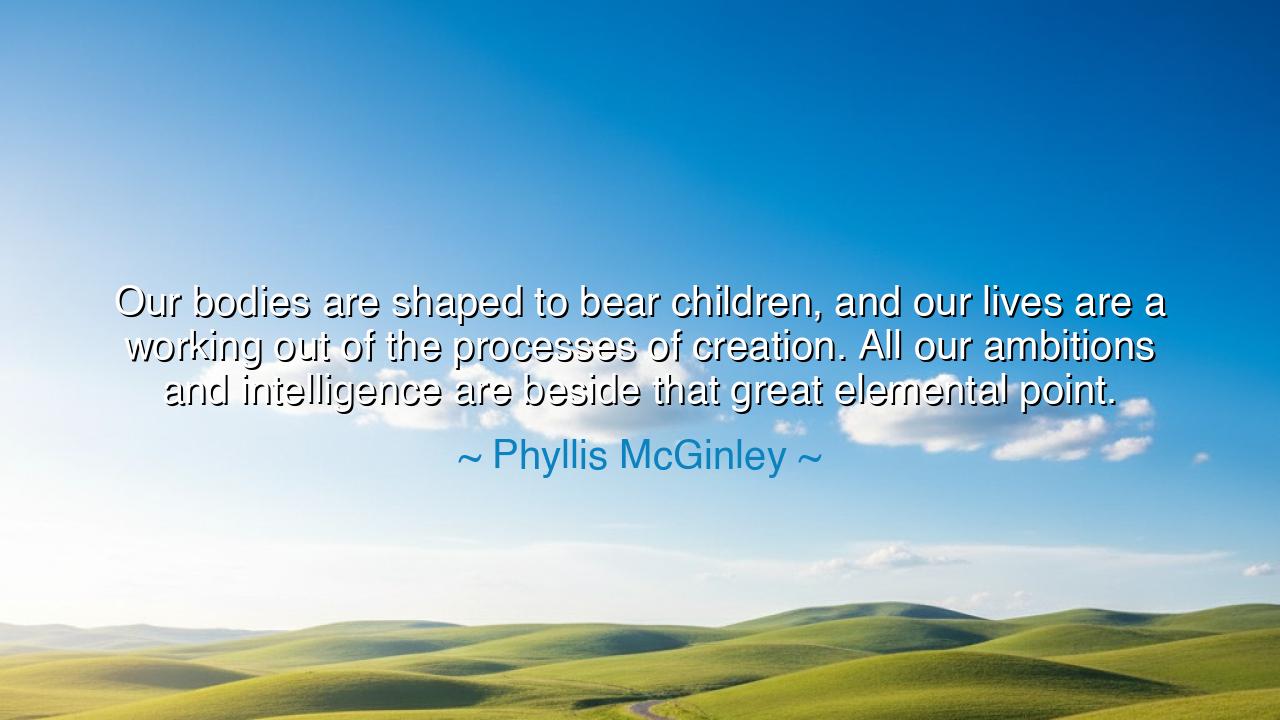
Our bodies are shaped to bear children, and our lives are a
Our bodies are shaped to bear children, and our lives are a working out of the processes of creation. All our ambitions and intelligence are beside that great elemental point.






“Our bodies are shaped to bear children, and our lives are a working out of the processes of creation. All our ambitions and intelligence are beside that great elemental point.” – Phyllis McGinley
In this profound and tender reflection, Phyllis McGinley, the poet of everyday wisdom, speaks to the sacred essence of womanhood, the eternal bond between life and creation. Her words do not diminish intellect or ambition, but rather illuminate a truth older than civilization itself — that the power to create life is among the greatest forces of the universe, and that within woman dwells a mystery both physical and divine. When she writes that “our bodies are shaped to bear children,” she speaks not only of anatomy, but of purpose, of the ancient rhythm by which humanity renews itself. The woman’s form, her cycles, her endurance, are not accidents of nature — they are manifestations of creation’s deepest will.
The origin of this quote lies in McGinley’s broader philosophy of celebrating the ordinary and the domestic, which she saw not as smallness but as sanctity. Writing in the mid-twentieth century, at a time when modernity began to pull women’s identities toward ambition and intellect, she sought to remind the world that creation itself begins at home, in the womb and in the heart. Her words do not stand against progress or equality; rather, they return to the elemental truth that all civilization — all learning, science, and art — flows from the first act of motherhood. For without those who bear and nurture life, there would be no world to build, no mind to enlighten, no dream to chase.
When McGinley speaks of “the processes of creation,” she invokes not only the birth of children, but the broader spirit of nurturing, forming, and sustaining life. Woman, she says, lives out this sacred process every day — in the care she gives, in the love she tends, in the quiet strength with which she shapes the world. Her intelligence and ambition, though powerful, find their ultimate purpose in the act of creation, whether through motherhood, art, or compassion. The phrase “beside that great elemental point” does not belittle the intellect; it places it in its rightful context — as a bright flame within the vast fire of being. The mind is a marvel, but the creation of life is the cosmos breathing through human flesh.
Consider the story of Marie Curie, the great scientist whose discoveries reshaped modern physics and medicine. She was a woman of brilliance, a seeker of truth — yet she was also a mother, raising two daughters amid her research. One of them, Irène Joliot-Curie, followed in her mother’s footsteps to win the Nobel Prize. Here, the process of creation took two forms: the birth of new life, and the birth of new knowledge. Yet both arose from the same source — the feminine capacity to nurture. Curie’s ambitions and intelligence were not beside the point, but illuminated by it: she embodied the union of intellect and creation that McGinley honors.
McGinley’s words also remind us that the act of bearing life is not confined to the physical. There are many who may never bear a child, yet who create in other sacred ways — teachers who awaken minds, artists who give form to truth, healers who restore the body, and dreamers who build a better world. The elemental point of creation runs through all of humanity, but in woman it takes a living shape — her very body echoes the creative power of the earth itself. Her capacity for empathy, her strength in endurance, and her quiet wisdom are all expressions of this same divine rhythm.
Yet McGinley’s reflection also serves as a meditation on humility. In a world that often glorifies intellect, progress, and achievement, she draws our gaze back to what sustains all of it — life itself. She reminds us that before ambition, before invention, there was the mother’s labor; before every empire or discovery, there was a birth. When we forget this, we risk losing our reverence for the sacred and the natural. The “elemental point” she speaks of is a call to gratitude — to remember that every human achievement rests upon the quiet, unseen work of creation.
So let this be the lesson: honor the creators, the nurturers, the mothers of the world, not only in body but in spirit. Recognize that intelligence and ambition find their truest power when they serve the work of life — when they uplift, protect, and bring forth goodness. Whether you bring new life into the world or breathe life into ideas, remember the sacred pattern that McGinley describes: that all of us are participants in the eternal process of creation. To live, then, is to create — and to create is to share in the work of the divine. In this truth, every woman, and indeed every human soul, finds both purpose and peace.






AAdministratorAdministrator
Welcome, honored guests. Please leave a comment, we will respond soon